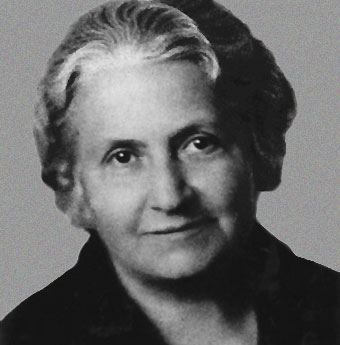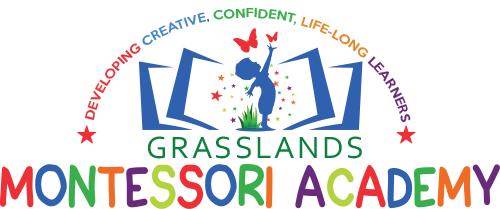

WHAT IS MONTESSORI?
Within a Montessori classroom, inspiring children to learn is approached in many non-traditional ways.
Within a Montessori classroom,
inspiring children to learn is approached in many non-traditional ways. Children are allowed to experience the excitement of learning by their own choice rather than by force. Consequently, learning is highly individualized, often with a hands-on approach. Dr. Montessori also believed in a vertical classroom. This allows children in a three-year age span to receive instruction together. Benefits of a vertical classroom are many. They include the opportunity for younger children to observe and practice behavior and skills modeled by older children. Older children have the opportunity to mentor younger children, therefore crystallizing their learning process. Knowledge is attained at the child’s pace, not the teacher’s. This promotes the maximization of future learning opportunities.
The Montessori Method
- A Rich and Extensive Curriculum
- Cross-Discipline Learning
- Testing by Portfolio
- Teaching Values
- Using Hands-on Materials
- Care for Our Global Enviroment
- School Setting with a "Family Atmosphere"
For nearly a century, perhaps one of the best-kept “secrets” in education has been the highly successful approach developed by the first woman physician in Italy, Dr. Maria Montessori. Dr. Montessori devoted her entire life to the process of educating children. Today, many modern theorists are discovering what Dr. Montessori knew 100 years ago – that children learn in many different ways.
Despite that fact that this program originated in 1901, the Montessori Method remains on the cutting edge of education reform.
Italian Educator and Physician - Marie Montessori

Maria Montessori, born in 1870, was an Italian educator and physician best known for developing the Montessori method of teaching young children. She was the first woman to obtain a medical degree through an Italian University. By 28 years of age, she was engaged in the medical profession assessing the needs of challenged children. Dr. Montessori went on to design materials and techniques that would permit these children to explore areas that were previously considered beyond their capacity. Her great moment came when these challenged children took the state examinations along with normal children and passed. Dr. Montessori concluded that if mentally challenged children could be brought to the same academic level as normal children, there must be something terribly wrong with the education of normal children.
In 1901 Montessori was appointed director of the Orthophrenic School of Rome, which had been used as an asylum to confine children with mental retardation. Drawing largely on the ideas of French educators Jean Itard and Edouard Séguin, Montessori provided the children with mental stimulation, meaningful activities, and opportunities to develop self-esteem. She received widespread recognition for her work when many of the adolescents at the school passed standard tests for sixth-grade students in the Italian public schools. Montessori believed that her methods would prove even more effective with children of normal intelligence.
In 1907 she opened the first Montessori school, or Children’s House, in a slum district of Rome, now famously known as Casa Dei Bambini. Within a year, observers came from around the world to see the progress made by Montessori’s students. Through her own observing and working with the children, she discovered their incredible, almost effortless, capability to absorb knowledge from their environment. She discovered that education is not something which a Teacher does but that it is a natural process that develops spontaneously in the human being. It is not acquired by listening to words but of experiences in which the child acts on his environment. She observed that children will teach themselves if they are given the opportunity and the proper environment. Dr. Montessori believed that no human being is truly educated by another person. They must do it for themselves or it will never be done. This profound and simple truth inspired her lifelong pursuit of educational reform, curriculum development, methodology, psychology, teaching, and teacher training. A “Montessori” environment cultivates a child’s own natural desire to learn.
Under Maria’s direction, before the age of five the children learned to read and write, they preferred work to play, and they displayed sustained mental concentration without fatigue. Montessori based her educational method on giving children freedom in a specially prepared environment, under the guidance of a trained director. She stressed that leaders of the classroom be called directors rather than teachers because their main work was to direct the interests of children and advance their development. According to Montessori, when a child is ready to learn new and more difficult tasks, the director should guide the child from the outset so that the child does not waste effort or learn wrong habits. The success of the Children’s House led to the founding of other Montessori schools and teacher-training programs throughout Europe and the United States. In 1934 Montessori fled fascist rule in Italy and settled in Barcelona, Spain. She worked there until the outbreak of the Spanish Civil War in 1936 forced her to move to The Netherlands. There she established an influential teacher-training school at Laren, near Amsterdam. From 1939 to 1947 Montessori lived in India and Ceylon (now Sri Lanka), founding more schools and training programs before returning to The Netherlands. Montessori was convinced that universal adoption of her teaching method would be of immense value in bringing about world peace, and she stressed the importance of education as the “armament of peace.”
This honored visionary woman died in 1952. Today, after more than 75 years of international application, the Montessori Method thrives in the United States with over 3,500 schools established since 1957. Montessori philosophy and methods are not limited to the private sector, but are being applied within the public school system and child care programs as well. Dr. Montessori’s focus on the individual child, the peaceful unfolding of the self, and the prepared classroom environment started a revolution in education that continues unabated.

